-
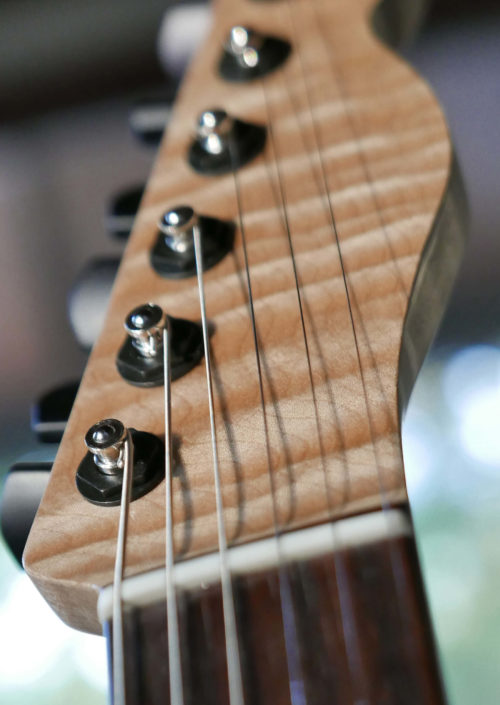 Another original, new, beautiful Custom Tele from master luthier Tony Nobles, based in Wimberly Texas. (Tony has crafted custom guitars for artists ranging in style from Joe Walsh to Alejandro Escovedo.) This guitar was custom made to our specs. And it’s one of one– the only one made with these features. Body: Figured Walnut top over adler Custom high end Musikraft quilted maple neck Width at the Nut: 1-11/16" Width at the Heel: 2-3/16 (55.56mm) Number of Frets: 21 Fret Type: Medium 6105 Finger Board Radius: 10" Body: natural, nitro lacquer finish Back of neck: natural, no finish Front of headstock: natural, nitro lacquer finish Bridge: Hannes by Schaller Non-Tremolo Bridge, #GTH RU-BLACK RUTHENIUM Tuners: Sperzel Trimlok Locking Guitar Tuners 6-in-line Trim-Lok Black Pickups: Harmonic Design "Vintage Plus" bridge and neck pickups
Another original, new, beautiful Custom Tele from master luthier Tony Nobles, based in Wimberly Texas. (Tony has crafted custom guitars for artists ranging in style from Joe Walsh to Alejandro Escovedo.) This guitar was custom made to our specs. And it’s one of one– the only one made with these features. Body: Figured Walnut top over adler Custom high end Musikraft quilted maple neck Width at the Nut: 1-11/16" Width at the Heel: 2-3/16 (55.56mm) Number of Frets: 21 Fret Type: Medium 6105 Finger Board Radius: 10" Body: natural, nitro lacquer finish Back of neck: natural, no finish Front of headstock: natural, nitro lacquer finish Bridge: Hannes by Schaller Non-Tremolo Bridge, #GTH RU-BLACK RUTHENIUM Tuners: Sperzel Trimlok Locking Guitar Tuners 6-in-line Trim-Lok Black Pickups: Harmonic Design "Vintage Plus" bridge and neck pickups -
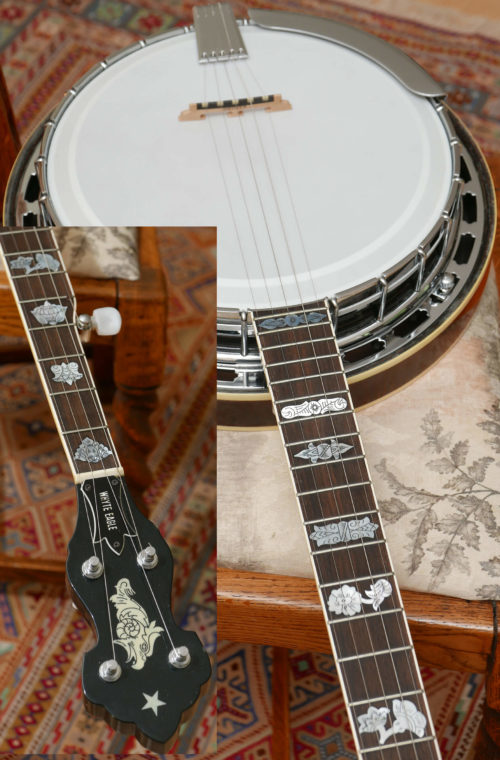 Early 1970s, but in remarkably original condition. And this instrument is from the first, early production– so it has the maple 3-ply rim. This should not be compared to later production Whyte Eagles– this is a very rare early one with unique features, and great tone. This banjo design is based on: • neck/head/inlays: based on the high end Fairbanks Whyte Ladye of the early 20th century– one of the most beautiful designs in banjo history • the pot assembly is modeled closely on the Gibson TB3, archtop of the 1930's. In fact it's a remarkable recreation of that design (and sound) – a more faithful recreation that many Gibson post-war versions. Bluegrass banjo players seek out the 70’s Alvarez Whyte Eagles, known for their tone and craftsmanship. It was a pretty short window of only about five years, when these banjos were made with this kind of craftsmanship. They blow away most any banjo made and marketed (from any country) in the 60s, 70s and 80s– and they show no logos on headstock– just beautiful mother of pearl. It’s the No. 4310 “Whyte Eagle”. Based on late 1920’s Vega Griffin (Tubaphone #9) style inlays, with engraved, carved heel. Sunburst finish maple banjo, Gibson-style 2 piece flange, full height 20 hole archtop tone ring, dual coordinator rods, flamed maple resonator, maple neck, chrome finish. Neck is butterfly with ebony strip on back of neck, down the center. It’s extremely rare to find a Whyte Eagle from this very early period (serial number 1672), when they first came out and the company bent over backwards to produce an instrument with zero compromise, from the inlays to the maple rim. The early features that are not on the later 70's Whyte Eagles, are– in addition to the 3-ply maple rim (not the 10-ply rim of almost all other Whyte Eagles)– the smaller star on the front of headstock (later models had a larger star), no “Alvarez” logo just the eagle inlay, and a darker sunburst on the resonator and also on the back of the neck. Flamed maple resonator (sunburst back, with a touch of milkiness to the original finish) Maple butterfly neck Hand-carved heel Mother of pearl inlays Original tuners Grover bridge 1 3/16 nut Scale: 26 ¼ inches 20 hole archtop tone ring 11 inch head ... no longer available ...
Early 1970s, but in remarkably original condition. And this instrument is from the first, early production– so it has the maple 3-ply rim. This should not be compared to later production Whyte Eagles– this is a very rare early one with unique features, and great tone. This banjo design is based on: • neck/head/inlays: based on the high end Fairbanks Whyte Ladye of the early 20th century– one of the most beautiful designs in banjo history • the pot assembly is modeled closely on the Gibson TB3, archtop of the 1930's. In fact it's a remarkable recreation of that design (and sound) – a more faithful recreation that many Gibson post-war versions. Bluegrass banjo players seek out the 70’s Alvarez Whyte Eagles, known for their tone and craftsmanship. It was a pretty short window of only about five years, when these banjos were made with this kind of craftsmanship. They blow away most any banjo made and marketed (from any country) in the 60s, 70s and 80s– and they show no logos on headstock– just beautiful mother of pearl. It’s the No. 4310 “Whyte Eagle”. Based on late 1920’s Vega Griffin (Tubaphone #9) style inlays, with engraved, carved heel. Sunburst finish maple banjo, Gibson-style 2 piece flange, full height 20 hole archtop tone ring, dual coordinator rods, flamed maple resonator, maple neck, chrome finish. Neck is butterfly with ebony strip on back of neck, down the center. It’s extremely rare to find a Whyte Eagle from this very early period (serial number 1672), when they first came out and the company bent over backwards to produce an instrument with zero compromise, from the inlays to the maple rim. The early features that are not on the later 70's Whyte Eagles, are– in addition to the 3-ply maple rim (not the 10-ply rim of almost all other Whyte Eagles)– the smaller star on the front of headstock (later models had a larger star), no “Alvarez” logo just the eagle inlay, and a darker sunburst on the resonator and also on the back of the neck. Flamed maple resonator (sunburst back, with a touch of milkiness to the original finish) Maple butterfly neck Hand-carved heel Mother of pearl inlays Original tuners Grover bridge 1 3/16 nut Scale: 26 ¼ inches 20 hole archtop tone ring 11 inch head ... no longer available ... -
Out of stock
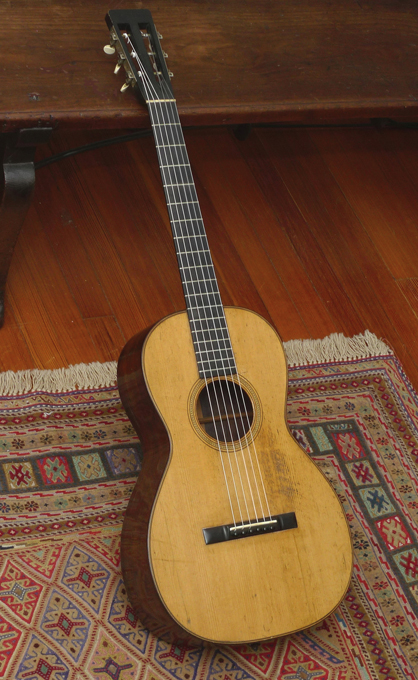 1855-1860 Martin “transitional”1-21. A very rare and exquisite large size Martin from the pre-1867 era. “Large size” Martin from the 1850’s, because the Size 1, and 0, were the only “large” size Martins in those years. And there is currently not a single other size 1 or 0 size pre-1867 Martin guitar on the market. This is considered by the top U.S. experts who vetted this instrument as an early, rare "transitional" 1-21, based on the fact that it does not have all the later, standardized, 1860’s and on “21” attributes– specifically, backstrip and endwedge on this instrument are not typical of “price-list” era 21’s (after the publishing of the first Martin price lists, establishing features of the different models, in the 1860’s) This 1-21 has:
1855-1860 Martin “transitional”1-21. A very rare and exquisite large size Martin from the pre-1867 era. “Large size” Martin from the 1850’s, because the Size 1, and 0, were the only “large” size Martins in those years. And there is currently not a single other size 1 or 0 size pre-1867 Martin guitar on the market. This is considered by the top U.S. experts who vetted this instrument as an early, rare "transitional" 1-21, based on the fact that it does not have all the later, standardized, 1860’s and on “21” attributes– specifically, backstrip and endwedge on this instrument are not typical of “price-list” era 21’s (after the publishing of the first Martin price lists, establishing features of the different models, in the 1860’s) This 1-21 has:- Diamond marquetry backstrip (not found on later, 1860’s 1-21s)
- Marquetry endwedge (not found on later, 1860’s 1-21s) (Wood end wedge and herringbone backstrip were the standard features of the 1860’s and after 1-21’s)
- X-braced. All braces are 100% original. No internal repairs to braces.
- Slot head
- Ebonized neck (maple neck, ebonized, i.e. painted black). This is another transitional feature: black neck was replaced by cedar on Style 21 by the time the Martin price list was first printed.
- Single "tone bar" brace behind the bridge plate
- Ice cream cone-shaped heel (1860’s 1-21’s had cedar neck, with Spanish style heel not ice cream cone heel)
- Three "CF Martin New-York" stamps: one inside center strip; the second on neck block (this stamp is upside down, as it should be); the third on back of guitar (near heel), the third stamp transversing the backstrip on the back of the guitar near the heel.
- Solid Brazilian Rosewood back and sides
- All original finish, everywhere; no touch-ups, overspray, etc, of any kind ever done
- Brazilian rosewood back shows beautiful sawmarks
- Bridge, more than a century old, is probably a replacement bridge… but on the original bridge footprint
- Original ivory nut
- Original bridge plate (mahogany)
- No back cracks, or side cracks; one top crack, repaired
- Tuners are modern replacements, vintage style, in original slot holes
- Original frets
-
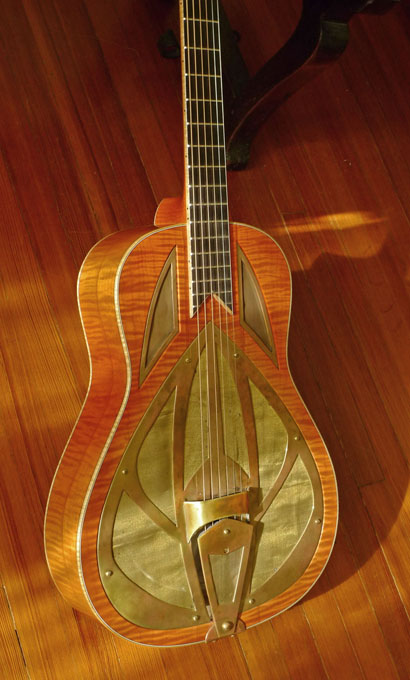 This stunningly beautiful, one-of-a-kind custom built resonator (from 2006, in beautiful crack-free condition and with only light wear) is from Tony Nobles, well-known luthier, and maker of instruments for Joe Walsh, Billy Gibbons and many other artists. The art deco ornamentation compliments an incredibly well built instrument, with meticulous attention to detail. Listen to/watch the video clip where guitar master Redd Volkaert put this instrument through some interesting jazz and blues paces.
This stunningly beautiful, one-of-a-kind custom built resonator (from 2006, in beautiful crack-free condition and with only light wear) is from Tony Nobles, well-known luthier, and maker of instruments for Joe Walsh, Billy Gibbons and many other artists. The art deco ornamentation compliments an incredibly well built instrument, with meticulous attention to detail. Listen to/watch the video clip where guitar master Redd Volkaert put this instrument through some interesting jazz and blues paces.- Spun-aluminum Quartermane biscuit-style cone (single-cone resonator)
- Solid curly maple, back top, and sides, with light tobaccoburst nitrocellulose lacquer finish
- Art deco coverplate, soundholes, and tailpiece of antiqued brass with a metal mesh covering
- Maple binding on body
- Custom torch inlay on headstock
- Curly maple neck
- Waverly tuners
- Scale: 24.4 inches
- Nut width: 1 7/8 inch
- String spacing at nut: 1 18/32
- Bridge spacing: 2 1/8
- Lower Bout: 14 1/2
- Upper bout: 9 1/2
- Body depth at bottom: 3 ¾ inches
- Body depth at neck joint: 3-20/32
-
 When this concert guitar was made in 1976, it was the top model offered by the master luthier Masaru Kohno– when he was at the very height of his career. There is some confusion out there as to which Kohno was the “top” concert model at any given date in height of Masaru Kohno’s career– from the early 70’s to the late-80s’. No confusion here– as there is correspondence (from August 2011) directly from Masaki Sakurai to us, regarding this guitar. Masaki Sakurai (nephew of Masaru Kohno, who in fact worked along side Masaru Kohno when this instrument was made in 1976, and now of course runs the “Sakurai/Kohno” shop, since the death of Masaru Kohno in 1998) confirms that this guitar was the top model available from Kohno in mid-1976. (Don’t be confused– a later, for example 1980 No. 30 Kohno is not a top Kohno model from that year. By 1980, the top model was a No. 50.) The confusion arises because Kohno had, in the early 70s until the late 80’s the custom of making his model numbers correspond to the guitars’ price in Japanese Yen. Hence, this guitar, a “No. 30”, in mid-1976, was priced at 300,000 Japanese Yen, and was the top model (a very expensive guitar in 1976). The confusion arises because as the inflation-prone 70’s continued, everyone adjusted prices upward. When inflation kept advancing, Kohno model numbers were something of a moving target, and the “top model” number changed upwards over time. Over time the top model moved up to No. 30 (this guitar), and then later No. 50 (starting in 1977). Kohno finally stopped using numbers in the 80’s and then called the top model the “Professional J”, and on, with more variations of “Professional”.) In any case this guitar, was the top model made, when it came from the Kohno shop (correspondence from Masaki Sakurai confirming this, will be supplied). But the real proof is in the playing. This instrument stands along with the best brazilian rosewood/spruce concert guitars from any maker, anywhere, any period. Crystal clear brazilian trebles. Wonderful resonance, combined with superior string separation.
When this concert guitar was made in 1976, it was the top model offered by the master luthier Masaru Kohno– when he was at the very height of his career. There is some confusion out there as to which Kohno was the “top” concert model at any given date in height of Masaru Kohno’s career– from the early 70’s to the late-80s’. No confusion here– as there is correspondence (from August 2011) directly from Masaki Sakurai to us, regarding this guitar. Masaki Sakurai (nephew of Masaru Kohno, who in fact worked along side Masaru Kohno when this instrument was made in 1976, and now of course runs the “Sakurai/Kohno” shop, since the death of Masaru Kohno in 1998) confirms that this guitar was the top model available from Kohno in mid-1976. (Don’t be confused– a later, for example 1980 No. 30 Kohno is not a top Kohno model from that year. By 1980, the top model was a No. 50.) The confusion arises because Kohno had, in the early 70s until the late 80’s the custom of making his model numbers correspond to the guitars’ price in Japanese Yen. Hence, this guitar, a “No. 30”, in mid-1976, was priced at 300,000 Japanese Yen, and was the top model (a very expensive guitar in 1976). The confusion arises because as the inflation-prone 70’s continued, everyone adjusted prices upward. When inflation kept advancing, Kohno model numbers were something of a moving target, and the “top model” number changed upwards over time. Over time the top model moved up to No. 30 (this guitar), and then later No. 50 (starting in 1977). Kohno finally stopped using numbers in the 80’s and then called the top model the “Professional J”, and on, with more variations of “Professional”.) In any case this guitar, was the top model made, when it came from the Kohno shop (correspondence from Masaki Sakurai confirming this, will be supplied). But the real proof is in the playing. This instrument stands along with the best brazilian rosewood/spruce concert guitars from any maker, anywhere, any period. Crystal clear brazilian trebles. Wonderful resonance, combined with superior string separation.- Hand-signed on label by Masaru Kohno, and dated 1976
- Solid European spruce top
- Solid Brazilian rosewood back and sides
- 660mm scale length
- Nut: 52mm
- Mahogany neck with 2 ebony supporting strips
- Ebony fretboard
- Gold engraved Gotoh tuners
- One repaired crack on back of guitar
- Crack-free top and sides. There are various nicks, dings, and scratches.
- Finish is naturally worn off, through playing, on the center section of the back of the neck– giving it a very fast feel in the left hand.
-
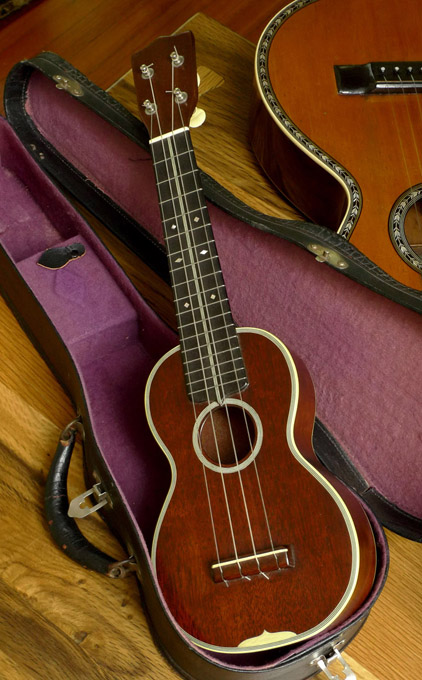 In the 1920’s and early 30's, the Hawaiian craze was in full bloom, and ukulele production was crucial to Martin’s success in this period. This is a wonderful, extremely well-preserved example of one of the most ornate of the Martin ukuleles, still in its original Geib case. Although Martin ukes built after 1916 carried no serial number, it’s possible to generally date them by stylistic elements. This Martin Style 3 is from the best era, the golden era, from about 1925 to 1930. Martin style 3 was first made in 1918. Martin Style 3, soprano (standard) specs:
In the 1920’s and early 30's, the Hawaiian craze was in full bloom, and ukulele production was crucial to Martin’s success in this period. This is a wonderful, extremely well-preserved example of one of the most ornate of the Martin ukuleles, still in its original Geib case. Although Martin ukes built after 1916 carried no serial number, it’s possible to generally date them by stylistic elements. This Martin Style 3 is from the best era, the golden era, from about 1925 to 1930. Martin style 3 was first made in 1918. Martin Style 3, soprano (standard) specs:- Mahogany body
- 7 layer top binding
- 3 layer back binding
- Ebony fretboard
- 5 layer soundhole ring
- Celluloid ornament on top, behind bridge (known as the "parend", or “shield”)
- Bar frets
- Small pearl paired-diamond inlays at fret 5, 7, and 9
- Three lines inlaid down center of fingerboard
- Nickel plated pegs (introduced in 1923)
- CF Martin & Co, stamped on back of peghead, and inside-back (Martin logo was not put on front of peghead until 1932)
-
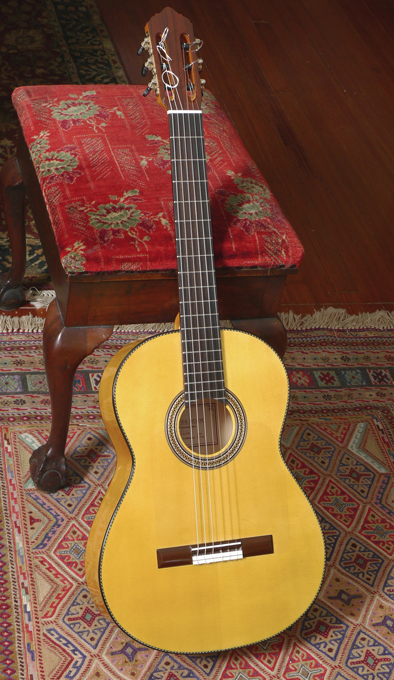 Brand new, Lester Devoe Flamenco Blanca, custom made (details on request). Lester Devoe needs no introduction to the world’s top flamenco players. His reputation was established decades ago (and his new models are the best ever made, and in huge demand worldwide). His guitars are played by the world’s top performing and recording flamenco artists. This instrument, custom made with a unique Spanish Cypress to add a more robust treble response to the legendary deep, throaty, percussive bass response of the Devoe Blanca, will amaze.
Brand new, Lester Devoe Flamenco Blanca, custom made (details on request). Lester Devoe needs no introduction to the world’s top flamenco players. His reputation was established decades ago (and his new models are the best ever made, and in huge demand worldwide). His guitars are played by the world’s top performing and recording flamenco artists. This instrument, custom made with a unique Spanish Cypress to add a more robust treble response to the legendary deep, throaty, percussive bass response of the Devoe Blanca, will amaze.- Flamenco Blanca
- 650mm scale length
- Spanish cypress back and sides (custom, details on request)
- European spruce top
- Ebony fingerboard
- Sloane tuners
- Rosewood headstock veneer
- Cedar neck
- Nitrocellulose lacquer finish
-
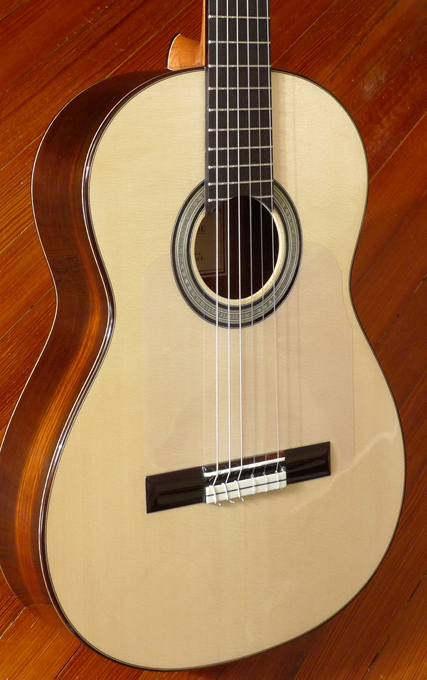 This new, custom made Lester Devoe Flamenco Negra is amasterpiece, from one of the world’s top luthiers. Lester Devoe needs nointroduction to the world’s great Flamenco players. The late, legendary Sabicasplayed a Devoe– and converted some of the great Flamenco players in Spain tothe fold. Paco De Lucia, and Vicente Amigo, among others, play Devoe Flamencoguitars. Paco De Lucia began playing a Devoe Negra guitar years ago– and thereare many Paco De Lucia recordings and feature films where Paco plays a DevoeFlamenco guitar.) This is the second custom guitar, that Lester has made for uswith select, old growth, quartersawn AAAAA Brazilian rosewood. Signed by LesterDevoe, 2012 (March).
This new, custom made Lester Devoe Flamenco Negra is amasterpiece, from one of the world’s top luthiers. Lester Devoe needs nointroduction to the world’s great Flamenco players. The late, legendary Sabicasplayed a Devoe– and converted some of the great Flamenco players in Spain tothe fold. Paco De Lucia, and Vicente Amigo, among others, play Devoe Flamencoguitars. Paco De Lucia began playing a Devoe Negra guitar years ago– and thereare many Paco De Lucia recordings and feature films where Paco plays a DevoeFlamenco guitar.) This is the second custom guitar, that Lester has made for uswith select, old growth, quartersawn AAAAA Brazilian rosewood. Signed by LesterDevoe, 2012 (March).- 650mm scale length
- Nut: 52mm
- Neck width at nut: 52mm
- 80 year old Brazilian Rosewood (pre-CITES) back and sides (Quartersawn).
- European spruce top
- Cedar neck
- Brazilian Rosewood headstock overlay, and bridge
- Brazilian Rosewood body binding, top and back
- Ebony fingerboard
- Sloane tuners
- Nitrocellulose lacquer finish
-
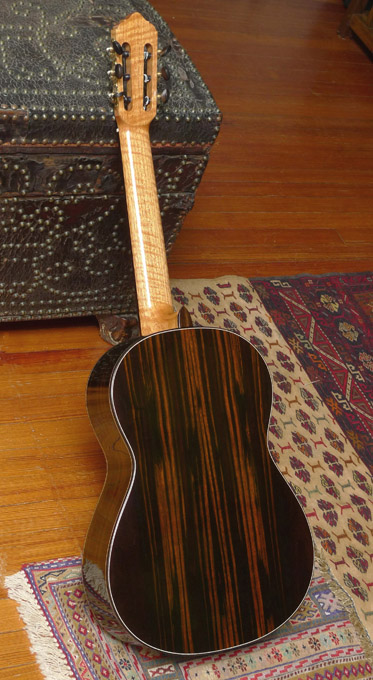 Vustom made Lester Devoe Flamenco Negra, a one-of-a-kind, Brazilian Rosewood guitar, from one of the world’s top luthiers. Lester Devoe needs no introduction to the world’s great Flamenco players. The late, legendary Sabicas played a Devoe– and converted some of the great Flamenco players in Spain to the fold. Paco De Lucia, and Vicente Amigo, among others, play Devoe Flamenco guitars. (I personally delivered a Devoe Flamenco Blanca guitar to Paco De Lucia in Spain in late 2010– Paco likes his Devoe’s hand-delivered. Paco De Lucia began playing a Devoe Negra guitar years ago– and there are many Paco De Lucia recordings and feature films where Paco plays a Devoe Flamenco guitar.) And it’s rare that Lester makes a Negra with Brazilian rosewood of this age and quality.
Vustom made Lester Devoe Flamenco Negra, a one-of-a-kind, Brazilian Rosewood guitar, from one of the world’s top luthiers. Lester Devoe needs no introduction to the world’s great Flamenco players. The late, legendary Sabicas played a Devoe– and converted some of the great Flamenco players in Spain to the fold. Paco De Lucia, and Vicente Amigo, among others, play Devoe Flamenco guitars. (I personally delivered a Devoe Flamenco Blanca guitar to Paco De Lucia in Spain in late 2010– Paco likes his Devoe’s hand-delivered. Paco De Lucia began playing a Devoe Negra guitar years ago– and there are many Paco De Lucia recordings and feature films where Paco plays a Devoe Flamenco guitar.) And it’s rare that Lester makes a Negra with Brazilian rosewood of this age and quality.- 650mm scale length
- Nut: 52mm
- Neck width at nut: 52mm
- String Spacing at nut: 44mm
- 80 year old Brazilian Rosewood (pre-CITES) back and sides (Quartersawn).
- European spruce top, with some beautiful and understated “"hazelfichte" (what Americans call bear claw).
- Custom, flamed Spanish Cedar neck
- Brazilian Rosewood headstock overlay, and bridge
- Brazilian Rosewood body binding, top and back
- Ebony fingerboard
- Sloane tuners
- Austere yet elegant Santos style black and white rosette, that Devoe uses only rarely, on top custom models
- Nitrocellulose lacquer finish
-
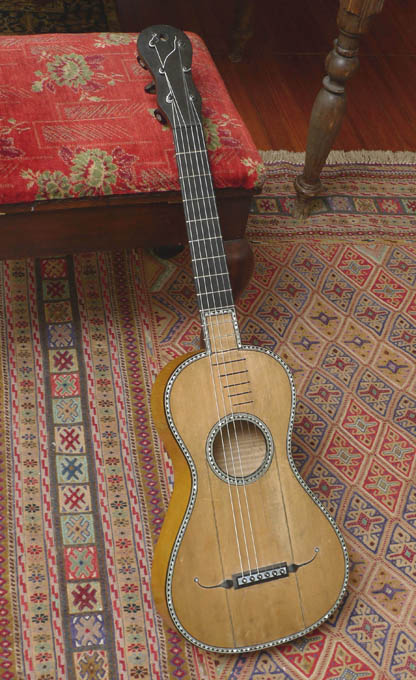 This fine and early example of the French guitar was made in Mirecourt, France, around 1800 to 1810. And sold through the famous Parisian dealer Koliker. It is a rare early example, as indicated by its rectangular bridge that does not have a separate saddle, but uses the top edge of the ebony rectangle as the saddle (this feature places it circa 1800, not like the more common 1820-1840 French guitars that have a more modern style bridge including a regular saddle). But for all its rarity, and exoticism to modern eyes, the most salient feature of this guitar is that it plays wonderfully. This is no museum piece to hang on a wall or shelf. This guitar is to play and enjoy. It plays beautifully, with all frets in tune. With no buzzing... I have had guitars from the 1960’s that do not play as well, in tune, and sound as well as this one. Even the action is perfect. The guitar has a wonderful tone, with a sweetness and brightness from the maple, and full bass response.
This fine and early example of the French guitar was made in Mirecourt, France, around 1800 to 1810. And sold through the famous Parisian dealer Koliker. It is a rare early example, as indicated by its rectangular bridge that does not have a separate saddle, but uses the top edge of the ebony rectangle as the saddle (this feature places it circa 1800, not like the more common 1820-1840 French guitars that have a more modern style bridge including a regular saddle). But for all its rarity, and exoticism to modern eyes, the most salient feature of this guitar is that it plays wonderfully. This is no museum piece to hang on a wall or shelf. This guitar is to play and enjoy. It plays beautifully, with all frets in tune. With no buzzing... I have had guitars from the 1960’s that do not play as well, in tune, and sound as well as this one. Even the action is perfect. The guitar has a wonderful tone, with a sweetness and brightness from the maple, and full bass response.- All original finish on the guitar
- Flamed solid Maple back and sides
- Spruce top, with no finish on the spruce… this is a characteristic of guitars from this time and place. While the back and sides of the guitar were French polished, the spruce top was left as natural wood, with no finish.
- One of the friction pegs is a modern replacement
- The two dark splices on the soundboard are later, but still 19th century, restorations, done as decorative flourishes.
- Scale length: 64.3 cm
- Length of body: 43.3 cm
- Koliker, Luthier Rue Croix-des-Petits Champs No. 24 A. Paris
-
Out of stock
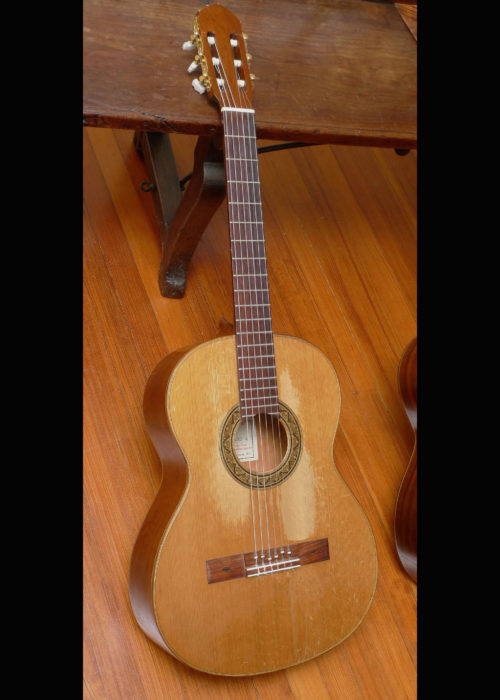
- Cedar top
- Depth at lower bout: 4 3/16 inches
- Width of neck at nut: 2 inches
- Body length: 19 3/4
-
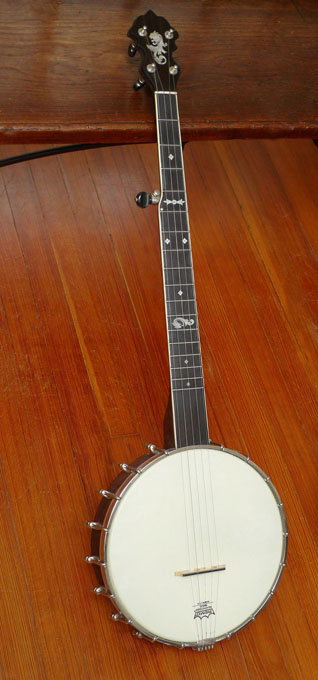 This is a one-of-a-kind custom banjo, from one of the country’s most respected luthiers, based in Appomattox, Virginia. I love this banjo for picking on the couch– it won’t put your back out, picking it up and putting it down, or crush your cat or your sweetheart. It’s lightweight, and with a custom-size head. But it packs beautiful full tone, not the tinny nasal sound from most open back banjos. It’s five or so years old, but with very little wear.
This is a one-of-a-kind custom banjo, from one of the country’s most respected luthiers, based in Appomattox, Virginia. I love this banjo for picking on the couch– it won’t put your back out, picking it up and putting it down, or crush your cat or your sweetheart. It’s lightweight, and with a custom-size head. But it packs beautiful full tone, not the tinny nasal sound from most open back banjos. It’s five or so years old, but with very little wear.- Dark stained maple rim, and neck
- 11 inch pot
- Ebony fretboard
- Engraved dragon inlay in peghead
- Custom MOP inlays
- Bound neck
- No Knot tail piece (Pat. Nov. 19 1901)
- 18 lug
- Brass hoop tone ring
- Dowell stick construction
- nut width 1-¼ inch
- scale: 25- ½ inches
- maple rim diameter: 10- ½ outside
- maple rim thickness: 7/16 inches
- Dark stained maple rim, and neck
- 11 inch pot
- Ebony fretboard
- Engraved dragon inlay in peghead
- Custom MOP inlays
- Bound neck
- No Knot tail piece (Pat. Nov. 19 1901)
- 18 lug
- Brass hoop tone ring
- Dowell stick construction
- nut width 1-¼ inch
- scale: 25-½ inches
- maple rim diameter: 10- ½ outside
- maple rim thickness: 7/16 inches
- With original case.